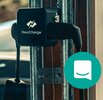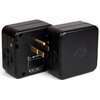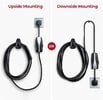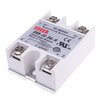Need help from the pro's, we are installing a second 14-50 outlet in the garage for a second tesla, the main panel has a 125 amps main circuit breaker, so 80% will be 100 amps, would it be possible to install a second outlet if the UMC charger pulls 28 amps, so having two UMC's will make it pull 56 amps. The A/c pulls between 25 to 30 amps but this is not continous and probably another 8 amps the for the electronics, do you think we are still Ok to install a second outlet, any help from every member is greatly appreciated.
Welcome to Tesla Motors Club
Discuss Tesla's Model S, Model 3, Model X, Model Y, Cybertruck, Roadster and More.
Register
Install the app
How to install the app on iOS
You can install our site as a web app on your iOS device by utilizing the Add to Home Screen feature in Safari. Please see this thread for more details on this.
Note: This feature may not be available in some browsers.
-
Want to remove ads? Register an account and login to see fewer ads, and become a Supporting Member to remove almost all ads.
You are using an out of date browser. It may not display this or other websites correctly.
You should upgrade or use an alternative browser.
You should upgrade or use an alternative browser.
Second 14-50 outlet
- Thread starter budweisman
- Start date
Wshowell
Member
Wshowell
Member
It splits the load or designates an alpha and a beta. I think it’s an ideal solution for what you were asking about. its built really well. It’s rare we have both our teslas at the cabin but my best friend has one, parents do too so if we have any guests, it’s likely they need to charge at the same time we do.
Need help from the pro's, we are installing a second 14-50 outlet in the garage for a second tesla, the main panel has a 125 amps main circuit breaker, so 80% will be 100 amps, would it be possible to install a second outlet if the UMC charger pulls 28 amps, so having two UMC's will make it pull 56 amps. The A/c pulls between 25 to 30 amps but this is not continous and probably another 8 amps the for the electronics, do you think we are still Ok to install a second outlet, any help from every member is greatly appreciated.
This is also a situation where, instead of two 14-50s, you would want two hard wired Wall connectors (tesla or otherwise) that can do powersharing and share the existing circuit.
Power sharing between EVs (so that if one is charging it gets the full power on the circuit, and if two are charging the EVSE balances the load between the two, allowing both to charge, and when one gets done the other one still charging goes back up to full power) is a good use case for having wall connectors.
I had one tesla gen 2 wall connector, just got a model Y for my wife to go with my model 3, and bought a second gen 2 wall connector and had my electrician run the cabling etc for them to share. Works great, but since you dont have any wall connectors, would be more expensive for you than if you find another solution.
Last edited:
Loading balancing with two or more Tesla Gen3 Wall Connectors requires Wi-Fi. There are other options. If your service panel (main panel) is really just 125A then you probably can't add another 50A circuit. If this is a 125A sub panel then you may have capacity for a second 50A circuit. If you are going to use the Tesla Gen2 Mobile Connector with the NEMA 14-50 plug adapter know that this setup is limited to charging at a maximum of 240V and 32A. You can, in situations where there is insufficient capacity for adding a 50A circuit use a 40A circuit breaker with a 14-50 receptacle. The Tesla Gen2 Mobile Connector with the 14-50 plug will charge at a maximum of 32A with either a 40A or 50A circuit breaker.
If one EV is driven less then you could even install a 30A circuit and use the NEMA 14-30 receptacle and plug for charging the second Tesla vehicle. There is no requirement for both charging circuits to have the same rating, amperage or charging speed.
Another option is a 3rd party EVSE (not Tesla) such as ClipperCreek (CC). CC offers several ways to charge two EVs using a single circuit. Although these are not inexpensive no Wi-FI is required for the load balancing.
A smart switch such as the NeoCharge would only enable one vehicle to charge at a time.
If one EV is driven less then you could even install a 30A circuit and use the NEMA 14-30 receptacle and plug for charging the second Tesla vehicle. There is no requirement for both charging circuits to have the same rating, amperage or charging speed.
Another option is a 3rd party EVSE (not Tesla) such as ClipperCreek (CC). CC offers several ways to charge two EVs using a single circuit. Although these are not inexpensive no Wi-FI is required for the load balancing.
A smart switch such as the NeoCharge would only enable one vehicle to charge at a time.
Last edited:
Thank you all for your quick reply, I think I have 2 options as of now, either we go with Neocharge which is about $500.00 or spend 2 wall chargers which is about $1k and I think they both do the same load sharing sharing. I think I'll go for Neo right now while I'll upgrade my panel to 200 amps then slowly convert it wall chargers, thanks again for your help.
patmurphey
Member
I believe Gen3 wall connectors have their own Wi-Fi to communicate.Loading balancing with two or more Tesla Gen3 Wall Connectors requires Wi-Fi...
The Gen3 Wall Connector's built-in Wi-Fi is only for configuring the Gen3 Wall Connector during setup using your phone, tablet or laptop. For advanced features including receiving Tesla updates and for load balancing for 2 to 6 Gen3 Wall Connectors each Gen3 Gen3 Wall Connector needs to connect to the local Wi-Fi network. Updates require internet access.I believe Gen3 wall connectors have their own Wi-Fi to communicate.
Watts_Up
Well-Known Member
I would stronly recommend that you read the following threads, and search for similar topics regarding NEMA 14-50 receptacle in this forum:Thank you all for your quick reply, I think I have 2 options as of now, either we go with Neocharge which is about $500.00 or spend 2 wall chargers which is about $1k and I think they both do the same load sharing sharing. I think I'll go for Neo right now while I'll upgrade my panel to 200 amps then slowly convert it wall chargers, thanks again for your help.
I would be very skeptical that the NeoCharge could hold the weight of two UMCs hanging without any overheating risk of bad connection:


You should always use a bracket to hold an UMC connector,
the plug is not designed for holding the weight, otherwise
there is always a risk of bad pin connection:

How the NeoCharge switches curent between the two plugs.
Are there some relays, or because of the size, any Solid State relays?
Honestly, I would not trust too much the NeoCharge device, especially the 50 Amp version.
The Website doen't provide any explanation how two cars can be charged simulanously.
Is there a timer, like 5 minutes each at a time, since there is no communication with the cars
to adjust the consumption to allow sharing the load?
I would prefer use two separate NEMA plugs using some possible configurations:
If you are charging only at night, to get lower rate, the second NEMA 30 Amp (24 Amp nominal)
running together with the NEMA 50 Amp (32 Amp UMC Max setting) so a total of 56 Amp,
and having AC (8 Amp) starting during the night, should not be too much load,
unless the AC In-Rush current could be an issue and trigger the main breaker.
You could help the charging load by using the timer inside the cars to avoid having both cars charging at the same time.
Or you could use an external timer and a relay to control the charge, a 50 Amp Solid State relay costs $12,
which is cheaper than the $500 NeoCharge.

Note: Do you really need to charge the two cars every night?
I personaly charge once a week, unless I have a long weekend trip.
If you always need to have the two cars charging every night, for lesser worry, you could use
two NEMA 14-30, so a total of 2 x 24 Amp = 48 Amp, there is not that much difference.
I charge using a NEMA 30 Amp overnight, and I have always my car full charged in the morning.
In conclusion, I would not recommend putting a multi-plug on top of a NEMA plug. Use two separate NEMA plugs instead.
You should probably consult with an electrician. But, if your main breaker panel is only 100 amps, I don't think you would have the ability to safely add another 14-50. Even if you were just calculating the 56 amps from the car charger, and your AC at 30 amps, you would still have things like the washing machine, dryer, TV, dish washer, oven, etc. to account for.
Jiver
Member
^^^^^Note: Do you really need to charge the two cars every night?
I personaly charge once a week, unless I have a long weekend trip.
This. It all depends on your driving habits, of course. My wife and I have an M3 and an MY and a single Gen 3 Wall Charger. We used to have a 20amp Clipper Creek EVSE. Even at 20amps we never had an issue keeping both cars charged enough to do what we needed to do on any given day. On any typical day I plug in my car when I get home from work and then switch to the other car before going to bed. For the worst case (which has not happened) we have a Supercharger located 10 miles away. Thus I have not felt the need for a second EVSE. YMMV.
Thank you all for your quick reply. Ok we have driver 1 drives to work 5 days a weeks, 50 miles round trip and my daughter drives between 40 to 100 miles, they were thinking charging it every night and I know 2 14-50 or UMC charger will most likely either tripped or overheat the main breaker. I think I would suggest them to get the 14-30 adapter (21 amps per charger) so we can reduce the load and be able to charge their cars at night. Do you think this is a better
@budweisman, an electrician would have to perform a load calculation according to the criteria in the National Electrical Code to determine what the spare capacity of your main panel is. You also need physical space to install a new double-pole breaker in your main panel (in case it is full - sometime half-size breakers can be used). From what you've described, though, my intuition tells me that you don't have enough capacity for two NEMA 14-50s at full charging load...But have an electrician do the load calculation and see what sort of electrical capacity you have left...
A single 30A circuit would charge at 24A (5.7kW) with up to 21 miles of range added per hour. 50 miles would take 2.5 hours, 100 miles would take 5 hours. Do you have capacity for adding 60A using (2) 30A circuits?Thank you all for your quick reply. Ok we have driver 1 drives to work 5 days a weeks, 50 miles round trip and my daughter drives between 40 to 100 miles, they were thinking charging it every night and I know 2 14-50 or UMC charger will most likely either tripped or overheat the main breaker. I think I would suggest them to get the 14-30 adapter (21 amps per charger) so we can reduce the load and be able to charge their cars at night. Do you think this is a better
If your electrician tells you that you don't have capacity for (2) 30A circuits then consider the Tesla Gen3 Wall Connectors with automatic load balancing. If you will have Wi-Fi service where the vehicles will be charging then (2) Tesla Gen3 Wall Connectors could share the charging circuit.
With load balancing a single 50A circuit would charge at 40A (9.6kW), (up to 36 miles per hour) with one vehicle charging, 4.8kW per vehicle with both vehicles charging (up to 18 miles per hour). 50 miles would take ~2.7 hours; 100 miles would take ~5.5 hours.
With load balancing a single 40A circuit would charge at 32A (7.7kW), (up to 29 miles per hour) with one vehicle charging, 3.8kW per vehicle with both vehicles charging (up to 14 miles per hour). 50 miles would take ~3.5 hours; 100 miles would take ~7 hours.
My solution for charging two cars was the Grizzl-E Duo EVSE. It can be set for lower amperages if needed, but it can do a max 40 amps when only one car is plugged in, 32 when both are plugged in (8 amps are reserved for the second car even if it isn't charging), and will send 20 amps to both cars when both are actively charging. It can't be hard wired but can be ordered with a 6-50, which I have, or a 14-50 plug. It has two 25 foot cables with J1772 ends, and I use the adapters that came with the cars. They include wall-mounted cable and plug holders that fit the plugs with the J1772 to Tesla adapter attached.
Compared to two Gen 3 wall connectors on a single circuit the Duo is slightly cheaper, simpler to install (just one plug, no WiFi, no firmware to update) and offers the flexibility to charge a future non-Tesla EV without an adapter, but at a sightly lower maximum rate (40 amps max vs 48, and in reality 32 if you always keep both cars plugged in). The thing is built like a tank. It has an all metal case and bracket, and surprisingly thick cables.
The only hiccup with the purchase and installation was I was expecting to hard wire it because the online owner's manual said you could do that, but it turned out that only applies to their single corded EVSEs. Customer service was pretty responsive in clearing that up and they had a revised manual on their site by the next day.
Compared to two Gen 3 wall connectors on a single circuit the Duo is slightly cheaper, simpler to install (just one plug, no WiFi, no firmware to update) and offers the flexibility to charge a future non-Tesla EV without an adapter, but at a sightly lower maximum rate (40 amps max vs 48, and in reality 32 if you always keep both cars plugged in). The thing is built like a tank. It has an all metal case and bracket, and surprisingly thick cables.
The only hiccup with the purchase and installation was I was expecting to hard wire it because the online owner's manual said you could do that, but it turned out that only applies to their single corded EVSEs. Customer service was pretty responsive in clearing that up and they had a revised manual on their site by the next day.
Similar threads
- Replies
- 82
- Views
- 3K
- Replies
- 5
- Views
- 324
- Replies
- 5
- Views
- 406
- Replies
- 9
- Views
- 448
- Replies
- 32
- Views
- 2K


